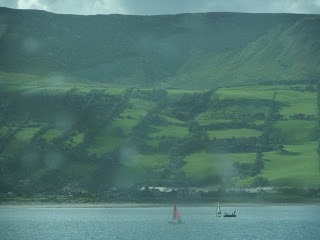August 28, 2011
It’s been a quiet week this week. All of a sudden, those of us who have been here since June and July are the ones who have been here the longest. We were the ones who were asked to offer leadership for the induction of the 10 new cycle 4 volunteers, who arrived on Wednesday evening. The pace has slowed down tremendously, as it is the transition week between the summer schedule and the schedule for the rest of the year.
All of a sudden there is breathing room, and time for personal space, reading, and the special projects that we each have had on the go. We hardly know what to do with ourselves. And, there are three Canadians in the new group! Hooray! It’s been wonderful, especially this week, in the aftermath of Jack Layton’s death, to connect with fellow travelers from Canada.
This weekend is also historically the “Corrymeela Community Work Weekend” ... when many community members come up for the weekend to work on the site, fixing, gardening, cleaning ... basically getting it ready and beautifying it for another year. Throughout the summer I have probably met about 25 community members (out of about 140) through their work with different groups that have been on site, or when they have arrived to do a week of volunteering on the weekly coordination team. This weekend offers the opportunity to meet many more. There are also several members from the Belfast L’Arche Community taking part in the weekend.
As Corrymeela Community members, folks agree to a “Statement of Commitment”, much like in other intentional Christian communities, such as the Iona Community in Scotland, or the Common Life Program at Tatamagouche Centre. This statement includes committing to work for an inclusive and just society, to pray regularly for each other, to give time and work to the community, to care for each other, and to give financial support to the community.
There are small “cell groups” all over Northern Ireland, and in Dublin. Although the community members come together several other times a year at the centre in Ballycastle, their work on behalf of the Corrymeela Community continues in the diversity of work and activities that they are about in their daily lives. Some are youth leaders, some are community organizers, some work for government agencies, some are university professors ... and the list goes on. (Again, the “Corrymeela begins when you leave” principle I talked about in my previous blog.)
Tomorrow, I’m off to Belfast again for a couple of days to get a sense of another aspect of Corrymeela’s work. Corrymeela has an office in Belfast with about a dozen staff members. In particular, I’m going to meet with Nicola McKeown who works in the Schools Programmes, which not only brings groups of school children to the Centre in Ballycastle, but goes into the schools with a virtue-based educational curriculum. This feels like very exciting work to me, and I’m interested to learn the specifics of how the curriculum has been developed, and how it is delivered.
I have only three and a half weeks left here at Corrymeela. I am fighting the urge to start thinking about the fall, and all the work that awaits me. And, I am still surprised at how my grief manifests itself on a daily basis ... and continue to remind myself that it’s only two weeks since my mother died. After many years of facilitating grief and loss workshops, I am reminded once again that grief manifests itself differently in each situation. I desperately want to be with friends and family, but also know that I am blessed to be in a place where there is time to slow down and process what has happened.
I hear the chain saws buzzing as I finish writing this. Time to go and join the community.

















